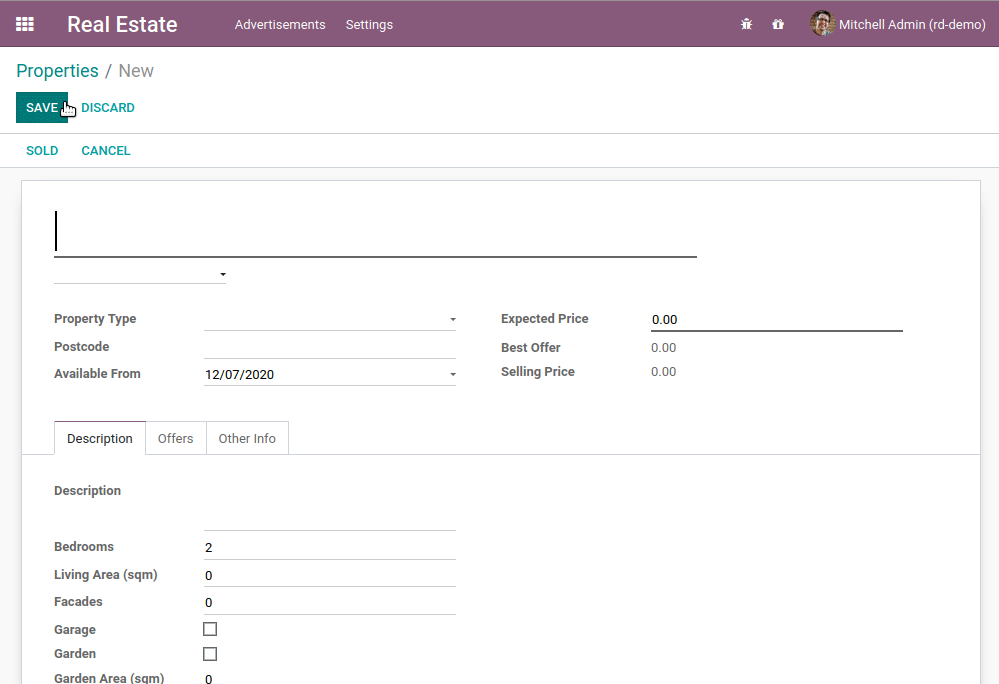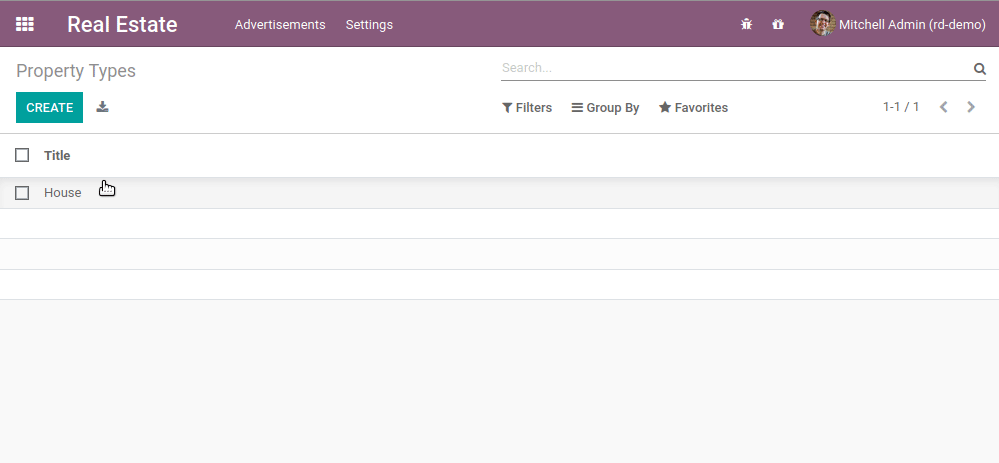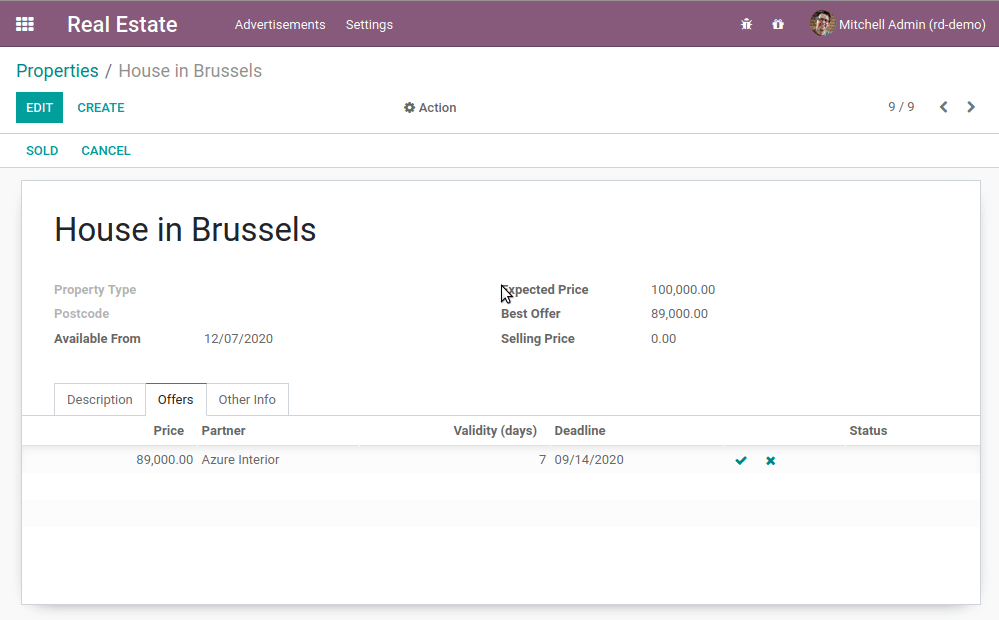odoo17 | 视图字段验证约束
发布时间:2024年01月06日
前言
前一章介绍了向模型添加一些业务逻辑的能力。现在我们可以将按钮链接到业务代码,但是我们如何防止用户输入错误的数据呢?例如,在我们的房地产模块中,没有什么可以阻止用户设置负预期价格。
Odoo提供了两种方法来设置自动验证的不变量:Python约束和SQL约束。
SQL约束
目标
- 金额应严格限制为正数

- 属性类型和标记应具有唯一的名称

SQL约束是通过模型属性**_sql_constraints定义的。这个属性被分配一个包含字符串(name、sql_definition、message)的三元组列表,其中name是一个有效的SQL约束名称,sql_definition是一个table_constraint**表达式,message是错误消息。
您可以在这里找到一个简单的示例:
# -*- coding: utf-8 -*-
# Part of Odoo. See LICENSE file for full copyright and licensing details.
from collections import defaultdict
from odoo import api, fields, models, _
from odoo.osv import expression
from odoo.exceptions import ValidationError
class AccountAnalyticDistribution(models.Model):
_name = 'account.analytic.distribution'
_description = 'Analytic Account Distribution'
_rec_name = 'account_id'
account_id = fields.Many2one('account.analytic.account', string='Analytic Account', required=True)
percentage = fields.Float(string='Percentage', required=True, default=100.0)
name = fields.Char(string='Name', related='account_id.name', readonly=False)
tag_id = fields.Many2one('account.analytic.tag', string="Parent tag", required=True)
_sql_constraints = [
('check_percentage', 'CHECK(percentage >= 0 AND percentage <= 100)',
'The percentage of an analytic distribution should be between 0 and 100.')
]
- name 为 check_percentage
- sql_definition 为 CHECK(percentage >= 0 AND percentage <= 100)
- message 为 The percentage of an analytic distribution should be between 0 and 100.
如果某些产品/服务的价格为零,则无法应用约束。您可以删除 有问题的数据,以便应用新的约束。
Python约束
*odoo.api.constrains(args)
修饰约束检查器。
每个参数必须是检查中使用的字段名:
@api.constrains('name', 'description')
def _check_description(self):
for record in self:
if record.name == record.description:
raise ValidationError("Fields name and description must be different")
在其中一个命名字段已被修改的记录上调用。
如果验证失败,将引发ValidationError。
警告
@constraints 只支持简单的字段名,不支持带点的名称(关系字段的字段,例如partner_id.customer),并且会被忽略。
只有当修饰方法中声明的字段包含在create或write调用中时,@constraints才会被触发。这意味着视图中不存在的字段将不会在创建记录期间触发调用。create的重写是必要的,以确保约束总是会被触发(例如,测试是值是否为空)。
- 也可以传递单个函数作为参数。在这种情况下,字段名是通过调用带有模型实例的函数来给出的。
目标
- 设置报价不能低于预期价格的 90%。

SQL约束是确保数据一致性的有效方法。然而,可能需要进行更复杂的检查,这需要Python代码。在这种情况下,我们需要一个Python约束。
Python约束被定义为一个用constraints()修饰的方法,并在记录集上调用。装饰符指定约束中涉及哪些字段。当修改这些字段中的任何一个时,将自动评估约束。如果不满足其不变量,该方法预计会引发异常:
from odoo.exceptions import ValidationError
...
@api.constrains('date_end')
def _check_date_end(self):
for record in self:
if record.date_end < fields.Date.today():
raise ValidationError("The end date cannot be set in the past")
# all records passed the test, don't return anything
在这里可以找到一个简单的例子:
@api.constrains('product_id')
def check_product_id(self):
if any(elem.product_id.type != 'product' for elem in self):
raise ValidationError(_('Quants cannot be created for consumables or services.'))
@api.constrains('quantity')
def check_quantity(self):
for quant in self:
if quant.location_id.usage != 'inventory' and quant.lot_id and quant.product_id.tracking == 'serial' \
and float_compare(abs(quant.quantity), 1, precision_rounding=quant.product_uom_id.rounding) > 0:
raise ValidationError(_('The serial number has already been assigned: \n Product: %s, Serial Number: %s') % (quant.product_id.display_name, quant.lot_id.name))
@api.constrains('location_id')
def check_location_id(self):
for quant in self:
if quant.location_id.usage == 'view':
raise ValidationError(_('You cannot take products from or deliver products to a location of type "view" (%s).') % quant.location_id.name)
- SQL 约束通常比 Python 约束更有效。当性能至关重要时,始终 首选 SQL 而不是 Python 约束。
我们的房地产模块开始看起来不错。我们添加了一些业务逻辑,现在我们确保 数据是一致的。但是,用户界面仍然有点粗糙。让我们看看如何 在下一章中改进它。
文章来源:https://blog.csdn.net/weixin_40986713/article/details/135423045
本文来自互联网用户投稿,该文观点仅代表作者本人,不代表本站立场。本站仅提供信息存储空间服务,不拥有所有权,不承担相关法律责任。 如若内容造成侵权/违法违规/事实不符,请联系我的编程经验分享网邮箱:chenni525@qq.com进行投诉反馈,一经查实,立即删除!
本文来自互联网用户投稿,该文观点仅代表作者本人,不代表本站立场。本站仅提供信息存储空间服务,不拥有所有权,不承担相关法律责任。 如若内容造成侵权/违法违规/事实不符,请联系我的编程经验分享网邮箱:chenni525@qq.com进行投诉反馈,一经查实,立即删除!
最新文章
- Python教程
- 深入理解 MySQL 中的 HAVING 关键字和聚合函数
- Qt之QChar编码(1)
- MyBatis入门基础篇
- 用Python脚本实现FFmpeg批量转换
- Transformer详解(附代码实现及翻译任务实现)
- 八大排序(超详细,万字总结)
- 整理了一些热门、含免费次数的api,分享给大家
- 《深入理解Java虚拟机(第三版)》读书笔记:Java内存区域与内存溢出异常、垃圾收集器与内存分配策略
- <软考高项备考>《论文专题 - 42 范围管理(1) 》
- Linux-进程间通信_管道
- SpringAMQP的使用方式
- No module named ‘fcntl‘
- Windows10开启本地代理设置
- 国科 GK7201V200 SOC芯片